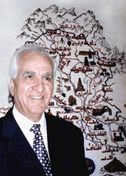Cultural Tourism and its Civilised Aspects
Islamic Tourism magazine’s participation at the International Symposium in Damascus proved successful as copies of the first issue were distributed there and were later on appreciated by those who attended this auspicious event. Below are our own brief views and comments on the three-day symposium:
The speakers were from different countries with various specilisations. Their topics enriched the symposium; however, the focus of most of them was on the archaeological and traditional landmarks
and how to preserve them. This means that other aspects of cultural tourism were not taken into consideration as much. Among these was:
The treasure-house of manuscripts and other scientific documents in libraries that are an important element of cultural, civilisational and human heritage, and which have been instrumental in introducing different types of knowledge throughout time.
This is of immense value to Islamic
countries for the reasons already mentioned in the first issue of our magazine.
Religious tourism reveals many perspectives in culture and economy. Exploring and developing religious landmarks and facilities would lead to the rise of tourism within Islamic countries.
The holy shrines, sanctuaries and mausoleums of prophets, guardians and ancestors from different religions, as well as the holy shrines of reformers and intellectuals who were central to mankind’s progress and flourishing.
These sites attract religious, cultural and scientific visitors, in particular Muslims, and are part of humanity’s spiritual heritage. In terms of the development and diver-sity of tourism, I briefed the symposium according to the following five comments:
Cultural tourism, such as archaeological sites, museums, palaces, visiting modern cultural developments within cities, and other related aspects. Economic tourism, such as fairs, symposiums, special visits by businessmen and tradesmen, and so on.
Physical tourism, such as active pursuits, including, among other things, hunting, yachting, car and bicycle racing, and so on. holiday tourism, such as visiting beaches and moun-taineering, especially in regions of the Islamic world where the weather is usually so hot that people generally wish to relax dur-ing the long, hot summer days.
Religious tourism, such as Hajj, Umrah, visiting the holy shrines of Imams, guardians and ancestors, as well as visiting mosques, mausoleums and monuments to prophets whose names are men-tioned in the Qur’an and other holy books.
Cultural Tourism
The prime objective of holding the symposium was to develop the economies of Arab and other countries in the area through tourism. The highlighting of landmarks and archaeological sites of the ancient human cultures that have inhabited the Islamic regions was just one of the ways of attracting tourists to these countries. This is a great task in itself and a source of pride for
the people of these lands. However, we should take into account how much the develop-ment of these sites costs in eco-nomic terms, and how much is their actual revenue worth. In other words, how many tourists are going to visit these sites from around the world? In brief, gov-ernments should not concentrate on one type of tourism and ignore others. Archaeological tourism alone cannot be the objective of attracting more tourists and, furthermore, it cannot flourish without other types of tourism, which should be marketed as secondary tourism. This could include festivals, excursions, school exchanges, voca-tional trips, family outings, and so on.
Economic Tourism
This requires a free-market economy which means the abolition of obstacles to travel, thereby enhancing the economic exchange among countries of the region on one hand, and with the world on the other. This should, of course, include economic conventions such as fairs, scientific and vocational symposiums, and so on. The time visitors and tourists spend should be qualitatively utilised by organising trips for them to archaeological and cultural sites.
Physical Tourism
See above
Summer Holidays
Programmes for trips to archaeological sites and museums should be arranged in such a way that the visitors’ time is not wasted, and that they are not bored.
Religious Tourism
This is of immense value to Islamic countries for the reasons
already mentioned in the first issue of our magazine. Religious tourism reveals many perspectives in culture and economy. Exploring and developing religious landmarks and facilities would lead to the rise of tourism within Islamic countries. This could very well produce a wider, more positive response. Relevant examples here might include:
The plan of the Kingdom of Saudi Arabia to extend Umrah to cover ten months in addition to the two months of the Hajj pilgrimage. The success already achieved in this respect has encouraged Saudi Arabia to announce that it is to attract more tourists to visit other landmarks in the country. It should also be noted that Saudi Arabia is considered to be one of the leading countries in properly organising and planning the receiving of thousands of tourists every day.
The city of Sayyidah Zaynab on the outskirts of Damascus used to be a small mosque with a shrine fifty years ago. It was a simple construction in the middle of a planting area. Today it has become one of the more remarkable landmarks of Greater al-Sham. Its population is 100,000, excluding the tens or perhaps hundreds of thousands of visitors and tourists who come to the area monthly. The government of Egypt has planned a huge tourist project for the archaeological Fatimid sites in Cairo and has prepared all the necessary maps to develop these sites in order to receive further tourists to view the landmarks more easily.
Iraq is also moving towards promoting Islamic Tourism, as Mr Abboud al-Tufayli, chairman of al-Najaf Trade and Commerce Chamber, and one of the delegates to the symposium, stated when he reiterated that the best investment in Iraq today is reli-gious tourism which can yield a high income within two years, especially in the sectors of hotels, accommodation, restaurants, and related services.
Finally, the Islamic Republic of Iran has arguably preceded all others in the area of promoting Islamic Tourism. Here, religious tourism has obtained a particular significance with the help of its citizens. Today, Iran can be a microcosm for analysis and study in the tourism sector.
The government of Egypt has planned
a huge tourist project for the archaeological
Fatimid sites in Cairo and has prepared all the
necessary maps to develop these sites in order
to receive further tourists to view the landmarks
more easily.
The recommendations of Islamic Tourism magazine in this issue address governments whose concern it is to boost cultural and other types of tourism. They have to start internally by:
Protecting the environment and beautifying the areas in the immediate vicinity of tourist sites, as well as providing these areas with the necessary services, including constructing ways to facilitate reaching them.
Establishing local tourist companies to organise regular trips for tourists, visitors and citizens by air-conditioned coaches to archaeological, cultural and tourist landmarks, including providing entertainment programmes for them.
Encouraging local, industrial and agricultural products, as well as traditional and popular handicrafts, for introduction and sale to tourists.
Considering the significance of the role of media and newspapers in highlighting the evolution in local and international tourism.
Considering the importance of media, newspapers and the internet to promote cultural tourism.
Preserving the environment, in particular the tourist sites and their surroundings.
Promoting the industrial, agricultural, and traditional crafts and popular products by introducing and selling them to tourists.
Beautifying the surrounding areas of tourist sites and providing them with the necessary services; setting up modern highways to reach them easily.
Promoting and facilitating local and international fairs that spe-cialise in publicising cultural tourism awareness.
Educating the people living around cultural sites, who are in close contact with tourists, by introducing to them the history and civili-sation of their area, promoting ideas of preservation and care of landmarks.
May God Bless one and all!
A. S. Shakiry
|

